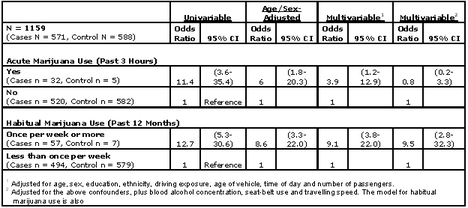Although there have been many studies investigating the dangers of driving under the influence of alcohol (Nochajski, 2006), few studies have investigated the dangers associated with driving under the influence of other psychoactive (i.e., mind-altering) substances. Preliminary research suggests that both acute marijuana use prior to driving and habitual marijuana use might affect driving ability and crash risk (UK Department for Transport, 2000). Impaired reaction time, attention, coordination and motor skills contribute to this increased risk (Hall, 2001). A more complete understanding of how marijuana use affects driving requires studies with larger sample sizes and assessment of multiple contributing risk factors. This week’s STASH discusses the relationship between driving under the influence of marijuana and car crash injuries (Blows, 2005).
Blows et al. recruited study participants in the Auckland region of New Zealand between March 1998 and July 1999. Study participants included 571 vehicle drivers involved in crashes that occurred during the study period in which at least one occupant of the car was hospitalized with injuries, or killed. The authors interviewed next of kin or a proxy respondent when a driver was fatally injured or otherwise unable to complete the interview. The authors used random cluster sampling of vehicle drivers throughout the study region to identify control subjects, of whom 588 participated. The case response rate was 92.8% (571 of 615), and the control response rate was 78.8% (588 of 746). All study participants completed a face-to-face or telephone-administered interview that collected basic descriptive information (i.e., drivers’ demographic characteristics, driving exposure, age of vehicle, time of day, and number of passengers), as well as several high-risk driving behaviors (i.e., sleepiness, high blood alcohol concentration, no seat-belt, and high traveling speed).
The questionnaire also included two self-report measures of marijuana use: acute use (i.e., marijuana use < 3 hours prior to the crash) and habitual use (i.e., marijuana use for an average of at least once per week during the past 12 months). The authors conducted multivariate analyses to calculate and compare the proportion of marijuana users in the study population to the proportion of marijuana users in the control population while adjusting for basic descriptive information and high-risk driving behaviors assessed in the questionnaire that might influence this association.
Figure. Associations between driving under the influence of marijuana and car crash injury of death (adapted from blows et al. 2005) * Changes made to the original table include switching habitual marijuana use of once per week or more from the reference row to the appropriate row with the associated odds ratio (the titles were revered in the original publication), along with a different title and the inclusion of the numbers of participants in each category. Click image to enlarge.
Marijuana use was more common among cases (acute use 6%, habitual use 10%) than among controls (acute use <1%, habitual use < 1%). As Table 1 shows, acute marijuana users have more than 11 times the risk of car crash injury or death compared to infrequent or non-users. However, after adjusting for high-risk driving behaviors (i.e., sleepiness, high blood alcohol concentration, no seatbelt, and high traveling speed) this association was no longer statistically significant. This suggests that these other high-risk driving behaviors exceed the influence of acute marijuana use. Habitual users of marijuana have nearly 13 times the risk of car crash injury or death compared to infrequent or non-users. This association remained statistically significant after adjusting for basic descriptive information and high-risk driving behaviors.
This study has several limitations. First, self-reported marijuana consumption might have led to biased assessment. For example, participants might under report marijuana consumption to avoid legal sanctions since possession and consumption of marijuana are illegal. In particular, there might be a greater tendency for underreporting among controls compared to cases because cases know that they are under scrutiny and might feel guilty about causing the accident. Second, the decision to interview next of kin or proxy respondents when the driver was unable to complete the interview also might have led to biased assessment because the proxy respondent might have been unaware of the driver’s marijuana consumption. Third, this study does not differentiate between different levels of marijuana consumption; therefore, the authors could not evaluate how the extent of marijuana use was associated with car crash injury. Fourth, it might be inappropriate for the authors to adjust the statistical analyses of acute marijuana use for the high-risk driving behaviors because drivers might be less likely to wear seat belts, and more likely to be sleepy and drive at higher speeds due to the effects of marijuana use (Hubbard, 1999; Rothman, 1998).
Despite these limitations, Blows et al. provide insight into the dangers of driving under the influence of marijuana. Their findings underscore the importance of educating the public about the dangers of driving under the influence of marijuana and other psychoactive drugs. Further research with more accurate measures of marijuana use needs to investigate the prevalence of driving under the influence of marijuana, and the relationship between marijuana use and risky driving behavior. Additional research on this matter holds the potential to inform the creation of effective public health interventions.
What do you think? Please use the comment link below to provide feedback on this article.
References
Blows, S., Ivers, R.Q., Connor, J., Ameratunga, S., Woodward, M., & Norton, R. (2005). Marijuana use and car crash injury. Addiction, 100(5), 605-611.
Hall, G. W., Degenhardt, L., Lynskey, M. (2001). The Health and Psychological Effects of Cannabis Use. Sydney: National Drug and Alcohol Research Centre, University of New South Wales.
Hubbard, J. R., Franco, S.E., Onaivi, E.S. . (1999). Marijuana: medical implications. American Family Physician, 60, 2583-2588.
Nochajski, T. H., Stasiewicz, P.R. (2006). Relapse to driving under the influence (DUI): A Review. Clinical Psychology Review, 26(2), 179-195.
Rothman, K. J., Greenland, S. . (1998). Modern Epidemiology (2 ed.). Philadelphia: Lippincott-Raven.
UK Department for Transport, U. D. f. (2000). Cannabis and Driving: A Review of the Literature and Commentary. London: Department for Transport.





